Stereotypes
Portrayed
Shocking
Unfair
Divisive
Discrimination
Unrepresentative
Scapegoating
Class
Pity
"Twitter Hate"
Sympathy
selection-reality show edited
victims
Bias
Class Protected unfair Discriminations Act
What responsibility do the programme makers, the broadcaster, the regulator and we as a society have?
they were told that the programme was about community spirit. They edited the parts to make it negative.
Some Twitter users pledged to assault the show’s participants if they saw them.
Monday, 29 February 2016
Wednesday, 24 February 2016
Question 3
What
have you learned from your audience feedback?
We needed to do a rough cut of our trailer
before we made our final product. We uploaded the video on YouTube and asked
for some feedback so that we could improve the trailer to what the final
trailer should look like.

YouTube is a free video sharing website that was launched in February 2005. It is one of the main websites that everyone uses. We thought to use YouTube as it is very popular, quick to upload videos, and to receive comments.
YouTube was used to upload the trailer so that it was easy for people to watch it to give feedback.
Feedback for the Rough Cut Trailer
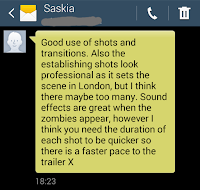
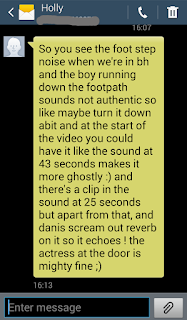
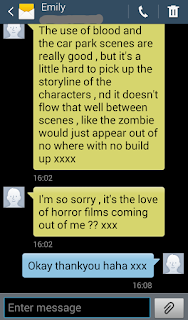
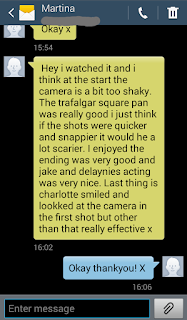
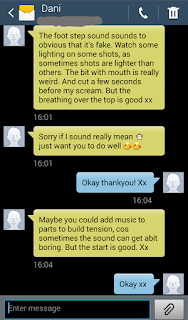
Tuesday, 23 February 2016
How well does contemporary media regulation protect the public essay
There are three media regulators for three types of media. BBFC (British Board of Film Classification) regulates films, OFCOM (Office of Communication) regulates television and PEGI (Pan European Game Information) regulates games.
The BBFC can be
effective because it uses age rating certificates to control what ages can
watch a particular film according to the guideline of what content- violence,
strong language etc. is appropriate for what age. The certificates are U, PG,
12A, 15 and 18. They also research the attitudes of people watching films
because society become desensitized as they have seen the same thing before in
other films so they become used to seeing it. For example, the film, “the Wild
One” was banned when it was released in 1953 but if we watched it nowadays we
would think the film would be a 12 age rating as the content that seemed For example,
the film, and “the hunger games” has a lot of violent scenes but because of the
context, the violence is acceptable. It was going to be a 15 but they cut
seconds of gore out of the violent scenes to make it a 12A. The age ratings can
help parents decide what film is appropriate for their children to watch as if
there wasn’t an age rating to judge by, they wouldn’t know what content is in the
film that their children want to watch. On the other hand, the BBFC can be seen
as not being as effective because you can access films online and some films
online could be banned like the film “the Human Centipede”. This film is an 18
is some countries and in the UK it is banned. When watching films online, you don’t
need to show that you are the right age to watch the film. BBFC can do nothing
if a parent or older friend purchases the DVD, and allows a younger audience
member to watch the film that is not age appropriate.
OFCOM deals with
any complaints that are made with programmes shown on the TV that could be
offensive to the viewers. For example, the TV show “Big Brother” gets thousands
of complaints as it is not scripted so they don’t know what the people in the
show will say as it is live and they are a re-active body. They decide what
parts to put on TV so if the show keeps showing extreme offensive content to viewers
they can give the company a warning and fine them. They have programs that are for older viewers shown
on television at a later time as the younger people are more likely to be in bed
at that time so they won’t be able to watch it. However, they receive
complaints after an episode has been aired so it is too late to cut anything
out of the episode.
PEGI regulates
by giving age certificates. They are a pro-active body so they inspect the
content of the game before it is released. For example, the game “Grand Theft
Auto” is rated an 18 as it includes a lot of violence as in one part there is a
mission where a man is interrogated and tortured. Violent games are blamed for
any dangerous behaviour of children that play these type of games. In an
article, it said that GTA influenced someone to be violent as they were re-enacting
a part in the game so this copycat theory can be dangerous if people can be
easily influenced from the media.
In conclusion, it
can be argued that we need to be shown violence in media as it is real life and
it could help us understand the world we live in that has this kind of
violence. I think that BBFC is the most effective when films are seen at the
cinema because it is easy to control who can watch it as you can be asked for
ID to see if you are the right age to watch the film. But I don’t think the
BBFC is very effective when films are shown on the TV, DVD’s and online films can
be watched by any age. I don’t think that OFCOM is very effective as they don’t
have a lot of control over who watches the TV show. In the future, I think the
regulators will be even more flexible as we will be desensitized to what we see
today making the age restrictions not as strict.
Monday, 22 February 2016
What is the purpose of the watershed?
The watershed means the time when TV programmes which might
be unsuitable for children can be broadcast.
Watershed begins at 9pm- 5:30am
Twice a year, every year, we ask parents and the wider
general public what they think about standards on TV. Almost everyone (93 per
cent) understands the watershed and 74 per cent think 9pm is the right time. If
you just ask parents, that number rises to 76 per cent.
About half of the complaints were made against ITV News,
which was the first to broadcast the footage on its 6.30pm bulletin on 22 May.
BBC News, 5 News, ITV News, Channel 4 News and Sky News are
among the broadcasters being investigated for showing the pre-watershed images.
ITV News defended the decision to air the footage, which was
preceded by a warning to viewers. A spokesman said: “It was editorially
justified to show such footage in the aftermath of such a shocking attack.”
Ofcom received more than 700 complaints about the footage.
The broadcaster said it was in the “public interest” to
screen the material since it was “integral to understanding the horrific
incident”.
Tuesday, 9 February 2016
Monday, 8 February 2016
Question 4
Post- Production
Trailer Editing
Final Cut Pro is an Editing Software that we used to edit
the trailer. In order to edit the footage, we had to import the footage, and
the sound into the software’s library. We moved what we wanted to use into the timeline
and rearranged the footage and sound around into the sequence we wanted.
(Screenshot here)
(Screenshot here)
The program has a blade tool that we used to cut down each
shot of footage to the length that we wanted. Then after we used the blade tool
to cut, we changed it back to the mouse tool to delete the footage. There is a
pen tool that we used to fade in and fade out the sound to make the sound flow
better with the footage. We also used text in Final Cut Pro to create titles.
We used Final Cut Pro for the animatic and the trailer. For
the animatic, we imported the photos of a storyboard that was drawn and we
dragged the photos individually in the order that we planned the trailer would
be in. We cut the shots on the animatic so they were a certain duration using
the blade tool and we added sound that related to each photo. The timing and
the duration of each shot were important because it helped us to see what the
trailer would look like with the editing and to see how long the trailer would
be so we knew if we had enough footage.
After we made the animatic we had to create the horror
trailer. We filmed some of the same shots of the animatic and changed the story
a little, as we thought of other shots to film. We used similar sounds to the
animatic as we could use the sounds that related to the same shots as the animatic.
To make it more like a trailer, we added titles with a black background and
added filters and video effects.
Sequence Timeline
The Sequence Timeline shows your footage and it helps you to see what order you have placed your footage and where you have placed the sounds to fit in with the footage and where the fades are. This sequence timeline doesn't look like the animatic that we thought it would look like but because we made adjustments to the order of the footage and where we placed the fades it looks different to the way we planned it.
Final Cut Pro Tutorial
As Final Cut Pro was new to us, we looked at YouTube to find tutorials on how to use Final Cut Pro and the effects that we could use to make it look more like a horror film. We thought that by using tutorials it would make it quicker for us to complete the tasks for making the animatic and th
e horror trailer than if we experimented with the software with
out any help. This is one of the tutorials that we looked at to help us get familiar with the software:
e horror trailer than if we experimented with the software with
out any help. This is one of the tutorials that we looked at to help us get familiar with the software:
Video Effects
Fade
(screenshot of fade on effects)
One of the effects that we used the most was adding fades because when we looked at examples of horror trailers to give us an idea of what we needed to include, the trailers used a lot of fades to build up the suspense. The screenshots show what the fade looked like in our trailer.
We thought that by using the black and white video effect it is more effective than seeing the footage in colour as it is seen more as a horror. The black and white effect is used when showing a close up of a zombie. We added the black and white video effect by clicking on the effects and dragging the black and white effect onto the footage you want to apply it to.
Bad TV
The Bad TV effect was sometimes used when the camcorder video effect was used to make it look out of focus and unbalanced and in horror films they usually use this Bad TV effect when showing the footage of the zombie because when they are shown on screen you can't see them very well.
We adjusted the colour to make it darker because the zombie wouldn't look as scary if there wasn't low key lighting.
Camcorder
This is where we found the camcorder video effect and we dragged this onto the footage that we wanted to apply it to.
The camcorder was added to make it look like CCTV footage that someone has found in the story and we also use this effect to look like someone is filming the zombie attack. The zombie film "REC" influenced us to use this technique. However we could have improved this effect by making the outline smaller to make it look more realistic.
Letterbox
(screenshot)
Text Effects
This screenshot shows the video effects that we have applied to this title. You can see that the video effects used are Bad TV, Letterbox and we have changed the background colour to red.
The Text also uses the earthquake effect because in horror trailers, the titles normally move out of place and we thought that the earthquake effect was the best one to use to suit the horror genre.
Sounds
Poster and Magazine
Examples of fonts
from the Poster and Magazine
Before using Photoshop, some drafts were made for the poster and magazine as a guideline of what they could look like after looking at existing horror posters and magazines. the
software this year and this gave us more time to think about how to layout the
poster and magazine as last year we was spending most of our time learning how
to use Photoshop.
Subscribe to:
Comments (Atom)


































